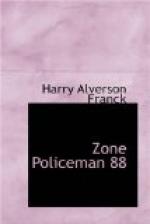But as I looked longer, noting how little by comparison were the trains I knew to be of regulation U. S. size, how literally tiny were the scores upon scores of men far down below who were doing this thing, its significance regained bit by bit its proper proportions. Train after train-load of the spoil of the “cut” ground away towards the Pacific; and here man had been digging steadily, if not always earnestly, since a year before I was born. The gigantic scene recalled to the mind the “industrial army” of which Carlyle was prone to preach, with the same discipline and organization as an army in the field; and every now and then, to bear out the figure, there burst forth the mighty cannonade, not of war, but of peace and progress in the form of earth-upheaving and house-rocking blasts of dynamite, tearing away the solid rock below at the very feet of the town.
I took to the railroad and struck on further into the unknown country. Almost before I was well started I found myself in another town, yet larger than Culebra and with the name “Empire” in the station building; and nearly every rod of the way between had been lined with villages of negroes and all breeds and colors of canal workers. So on again along a broad macadamized highway that bent and rose through low bushy ridges, past an army encamped in wood and tin barracks on a hillside, with khaki uniformed soldiers ahorse and afoot enlivening all the roadway and the neighboring fields. Never a mile without its town—how different will all this be when the canal is finished and all this community is gone to Alaska or has scattered itself again over the face of the earth, and dense tropical solitude has settled down once more over the scene.
Panama, they had said, is insupportably hot. Comparing it with other lands I knew I could not but smile at the notion. Again it was the lack of perspective. Sweat ran easily, yet so fresh the air and so refreshing the breeze sweeping incessantly across from the Atlantic that even the sweating was almost enjoyable. Hot! Yes, like June on the Canadian border—though not like July. It is hot in St. Louis on an August Sunday, with all the refreshment doors tight closed—to strangers; hot in the cotton-fields of Texas, but with these plutonic corners the heat of the Zone shows little rivalry.
The way led round a cone-shaped hill crowned by another military camp with the Stars and Stripes flapping far above, until I came at last in sight of the renowned Chagres, seven miles above Culebra, to all appearances a meek and harmless little stream spanned by a huge new iron bridge and forbidden to come and play in the unfinished canal by a little dam of earth that a steam-shovel will some day eat up in a few hours. Here, where it ends and the flat country begins, I descended into the “cut,” dry and waterless, with a stone-quarry bottom. A sharp climb out on the opposite side and I plunged into rampant jungle, half expecting snake-bites on my exposed ankles—another pre-conceived notion— and at length falling into a narrow jungle trail that pitched down through a dense-grown gully, came upon a fenced compound with several Zone buildings on the banks of the Chagres, down to which sloped a broad green lawn.




